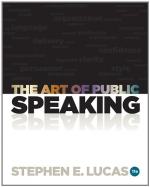The Saturday Evening Post in an article on “England’s T.R.”—Winston Spencer Churchill—attributed much of Churchill’s and Roosevelt’s public platform success to their forceful delivery. No matter what is in hand, these men make themselves believe for the time being that that one thing is the most important on earth. Hence they speak to their audiences in a Do-this-or-you-PERISH manner.
That kind of speaking wins, and it is that virile, strenuous, aggressive attitude which both distinguishes and maintains the platform careers of our greatest leaders.
But let us look a little closer at the origins of inner force. How does conviction affect the man who feels it? We have answered the inquiry in the very question itself—he feels it: Conviction produces emotional tension. Study the pictures of Theodore Roosevelt and of Billy Sunday in action—action is the word. Note the tension of their jaw muscles, the taut lines of sinews in their entire bodies when reaching a climax of force. Moral and physical force are alike in being both preceded and accompanied by in-tens-ity—tension—tightness of the cords of power.
It is this tautness of the bow-string, this knotting of the muscles, this contraction before the spring, that makes an audience feel—almost see—the reserve power in a speaker. In some really wonderful way it is more what a speaker does not say and do that reveals the dynamo within. Anything may come from such stored-up force once it is let loose; and that keeps an audience alert, hanging on the lips of a speaker for his next word. After all, it is all a question of manhood, for a stuffed doll has neither convictions nor emotional tension. If you are upholstered with sawdust, keep off the platform, for your own speech will puncture you.
Growing out of this conviction-tension comes resolve to make the audience share that conviction-tension. Purpose is the backbone of force; without it speech is flabby—it may glitter, but it is the iridescence of the spineless jellyfish. You must hold fast to your resolve if you would hold fast to your audience.
Finally, all this conviction-tension-purpose is lifeless and useless unless it results in propulsion. You remember how Young in his wonderful “Night Thoughts” delineates the man who
Pushes his prudent purpose
to resolve,
Resolves, and re-resolves,
and dies the same.
Let not your force “die a-borning,”—bring it to full life in its conviction, emotional tension, resolve, and propulsive power.
Can Force be Acquired?
Yes, if the acquirer has any such capacities as we have just outlined. How to acquire this vital factor is suggested in its very analysis: Live with your subject until you are convinced of its importance.
If your message does not of itself arouse you to tension, PULL yourself together. When a man faces the necessity of leaping across a crevasse he does not wait for inspiration, he wills his muscles into tensity for the spring—it is not without purpose that our English language uses the same word to depict a mighty though delicate steel contrivance and a quick leap through the air. Then resolve—and let it all end in actual punch.




